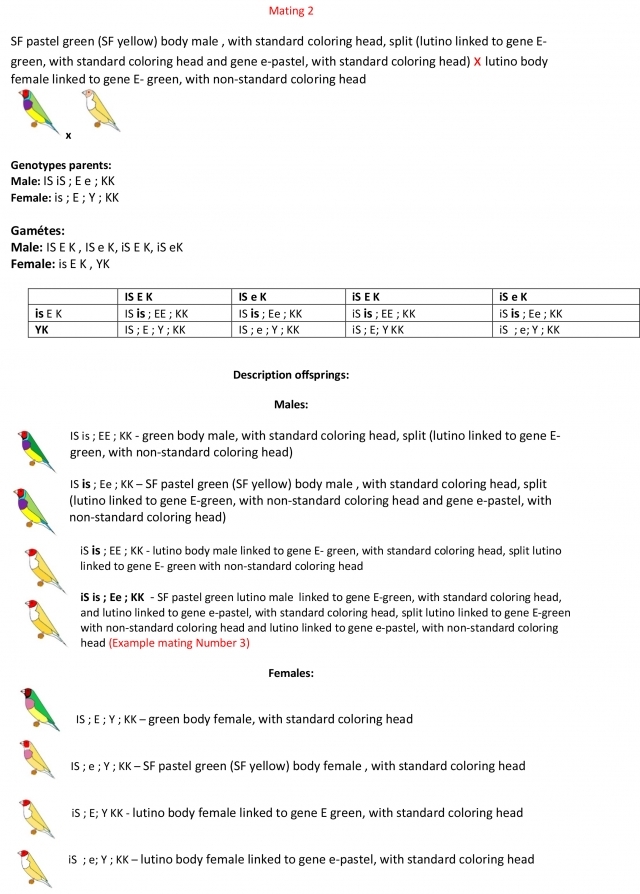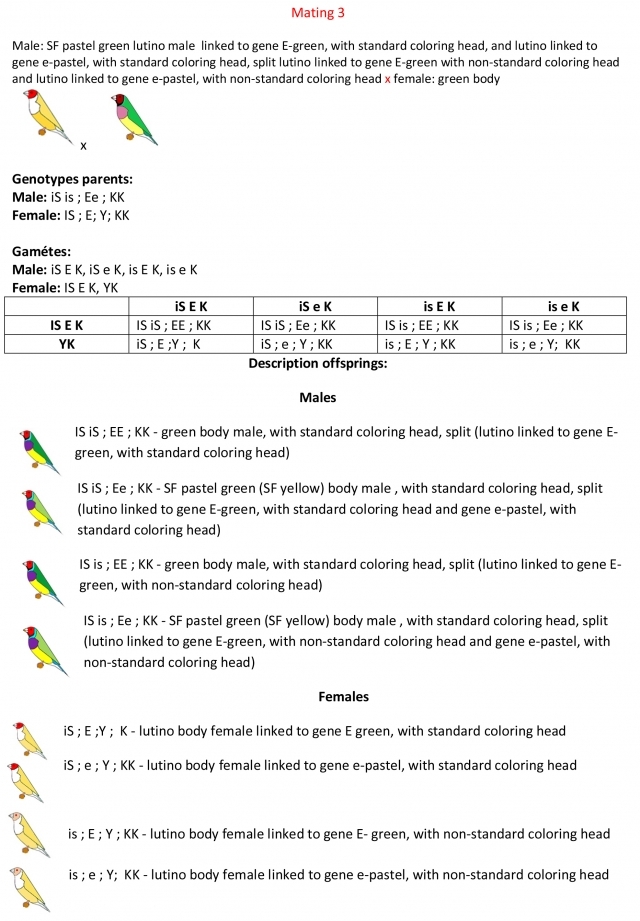Coloring head with ino mutation
Occurrence and formation of the ino mutation in Gouldian Finches
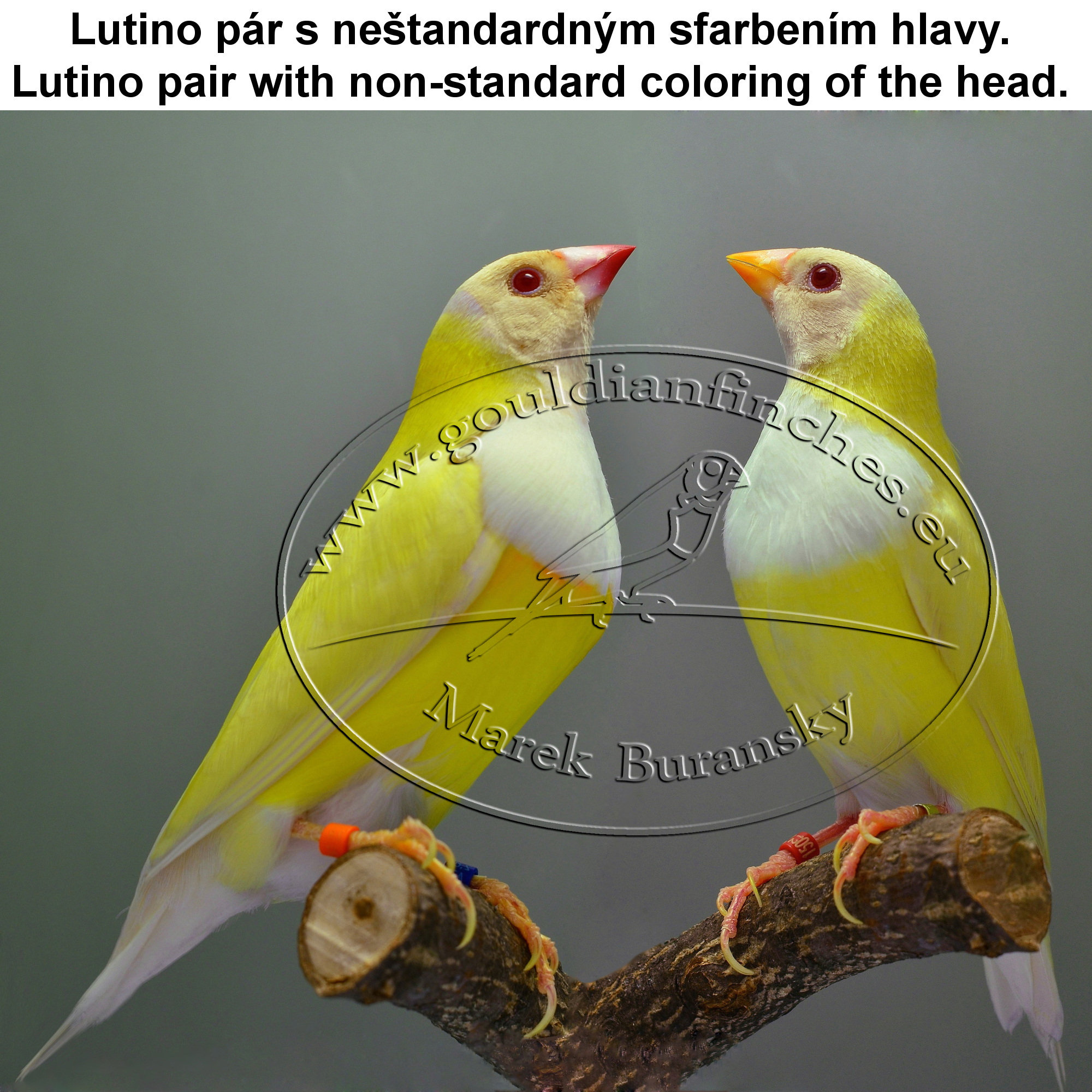 To begin with, I’d like to emphasize, that even if I think only one ino gene exists, that doesn’t mean it cannot be activated by different means. Modifiers, i.e. genes, which modify the oxidation of tyrosinase and thus activate the ino gene may be of different origins. That means that ino mutations may occur either spontaneously or by hybridization as is mentioned in the text below. Ino mutations are recessive and sex-linked.
To begin with, I’d like to emphasize, that even if I think only one ino gene exists, that doesn’t mean it cannot be activated by different means. Modifiers, i.e. genes, which modify the oxidation of tyrosinase and thus activate the ino gene may be of different origins. That means that ino mutations may occur either spontaneously or by hybridization as is mentioned in the text below. Ino mutations are recessive and sex-linked.
This article specifies four lines of Gouldian Finches. It does not attempt to sort these lines by the means of ino gene activation. Ino mutation is a mutation, in which the ino gene is actually linked to either the S-gene or the s-gene, which are responsible for the coloring, or discoloring of the head, as well as with the unmutated E-gene, or mutated e-gene, which results in the occurrence of the pastel mutation.
We can say, with certainty, that ino Gouldian Finches, which do not exhibit standard head coloring, come from hybridization, as described below. By means of crossing-over cases may occur, where the head feathers exhibit standard colors, but the birds may still come from hybridization. So the situation is, therefore, one where we have ino Gouldians with standard head coloring, which were created as a true-spontaneous mutation and we also have birds, which exhibit standard head coloring, but are originally products of hybridization. It is an example of lines no. 3 and 4.
I would also like to emphasize, that, especially in English speaking countries, the term SF pastel – green is used for females. This nomenclature is incorrect. By the term pastel mutation we may label any mutation where dark pigments are reduced. Yellow color in Gouldian Finches is incompletely dominant and sex-linked. That is why we have yellow Gouldians, SF and DF male and hemizygous females, i.e. they do not have a pair allele for the yellow color. Therefore females may not be SF pastel green, they are simply yellow.
Genetic disorders of pigment production are labeled as albinism. The base for the occurrence of such disorders is a flaw in the transportation of tyrosine through the cellular membrane, or the presence of defective enzymes, which take part in converting tyrosine to melanin. Lutino is the deficiency of dark pigments in the yellow line, albino is the deficiency of dark pigments in the blue line. Albino is therefore a combination of lutino and blue.
Ino mutations and especially lutino mutations can be seen with two types of head coloring. There are lutino birds, which do not appear with the standard head coloring, i.e. red and yellow, and there are lutino birds, which can be seen with these standard colors. My current findings show that we now have the following lines of ino birds:
1. ino mutation linked to the (yellow) pastel mutation (e-gene) with non-standard head coloring;
notation: is is; ee
2. ino mutation not linked to the pastel mutation (E-gene) with non-standard head coloring;
notation: is is; EE
3. ino mutation linked to the (yellow) pastel mutation (e-gene) with standard head coloring;
notation: iS iS; ee
4. ino mutation not linked to the pastel mutation (E-gene) with standard head coloring;
notation: iS iS; EE
To also explain how is it possible that a change in color and structure of the plumage occurred, we need to introduce the s-gene, which is responsible for feather structure in the Blue-faced Parrotfinch (Erythrura trichroa). It seems, that this gene, in close link with the ino gene, got transferred from Blue-faced Parrotfinches (Erythrura trichroa) onto ino mutations of Gouldian Finches. This gene causes a change in the feather structure, which is similar to the feather structure of black-headed Gouldians. This change in feather structure prevents the storage of carotenoids (yellow lutein and red canthaxanthine) in the feather barbs. The feathers possess a structure which is linked to the ino gene in the Blue-faced Parrotfinches.


 Photographs taken from the head feathers confirm, that by this interspecies breeding a gene, or gene-group, has been transferred onto the Gouldians, which encode feather structure. On the heads of ino Gouldian Finches described under points 1.and 2. we do not observe the standard plumage as can be seen on other Gouldian Finches, but plumage bearing changes from hybridization. The feathers are therefore the feathers of hybrids.
Photographs taken from the head feathers confirm, that by this interspecies breeding a gene, or gene-group, has been transferred onto the Gouldians, which encode feather structure. On the heads of ino Gouldian Finches described under points 1.and 2. we do not observe the standard plumage as can be seen on other Gouldian Finches, but plumage bearing changes from hybridization. The feathers are therefore the feathers of hybrids.
Characteristic of the s-gene – feather structure
This trait, which I call a gene is an auxiliary symbol, so it is possible to define different head colorings, i.e. typical and atypical. The S-gene encodes a feather structure, which is typical for the Gouldians, meaning mostly of red and yellow color, while the s-gene encodes the feather structure, which was transferred onto the ino mutation of Gouldian Finches via hybridization from the Blue-faced Parrotfinch, the s-gene does not enable standard head coloring to show in the ino Gouldians.
Since we are unaware what exactly is going on on the genetic level, the term ‘gene’ represents a symbol in Mendelian genetics to enable calculations. In fact, it may not be a single gene at all, it may be a complex gene sequence or a case of gene interaction. On the outside, this appears as a single trait, so for the purposes of calculation I labeled it as a gene. I will continue to use this notation, until a detailed examination of the Gouldian genome has been carried out.
The s-gene which causes the changes in feather structure appears to be a gene completely linked to the European ino mutation. It is reasonable to assume that it does not bond with an inactive ino gene. Examples of breeding birds with typical and atypical head coloring can be found later on in this paper.
In standard calculations, where head coloring is not an issue, we do not list the S-gene.
Head feathers of the examined specimens
On the provided images of black-headed Gouldians we may see the structure, consisting of all aforementioned parts, i.e. the shaft, the barbs and the barbules. Each of these parts stores pigment grains, both colored and uncolored. A similar structure can be seen in the head feathers of the Blue-faced Parrotfinch (Erythrura trichroa) and also on the head feathers of ino Gouldian Finches, which show no coloring. It is clear, that ino Gouldians have head feathers, which are influenced by the s-gene, which is responsible for feather structure and which was transferred onto the Gouldians via hybridization.

Red and yellow-headed Gouldians do not have barbules on the tips of the barbs, as is the case in black-headed birds. Ino birds, which come from hybridization and which carry the hybrid gene also have barbules formed on the tips of the feather barbs.
To achieve standard head colors in ino Goudlians, it is necessary to separate the hybrid s-gene, responsible for feather structure changes and closely linked to the ino mutation, from the gene pool. If the plumage is unaffected by this gene, feathers may be produced with a structure that allows storage of carotenoid pigments and therefore standard head coloring may occur.

On the photo you can see the male lutino, it can be seen that the s gene, which encoded the feather structure similar to the Parrotfinches, has been separated and the ino gene is no longer linked with this gene. These birds then show head coloring in colors that are typical for their own species.
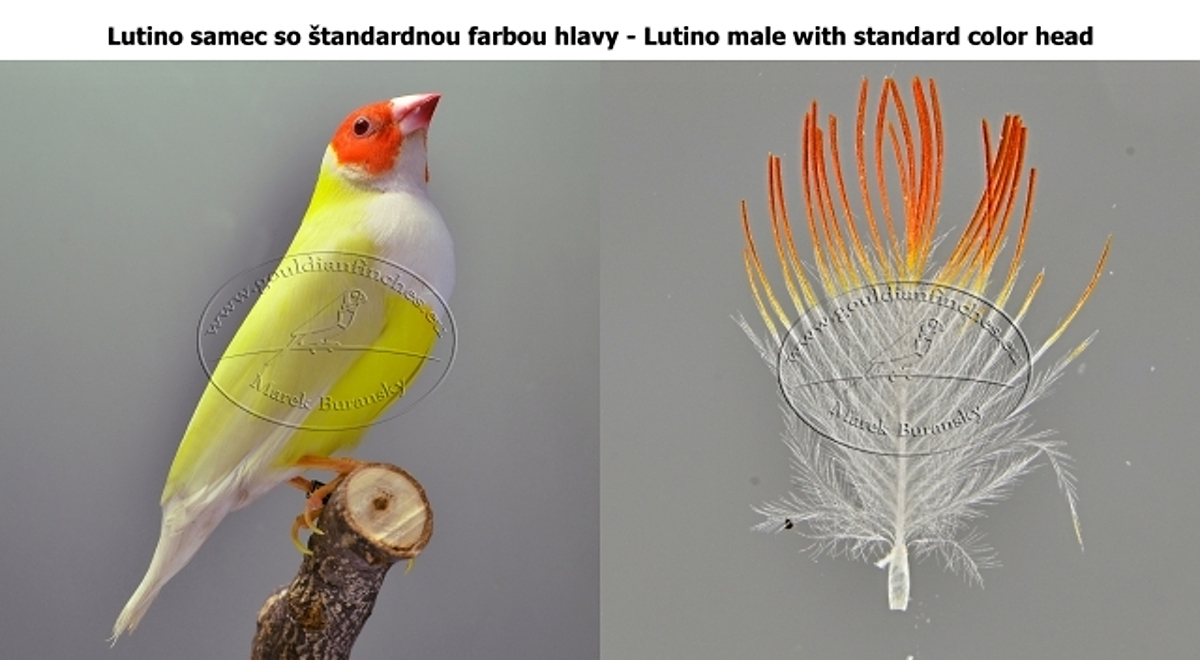
In the US, but also in Europe lutino birds with typical head coloring may be found. Some examples may be seen on the images of feathers, sent to me by Mrs. McAlpin from her Gouldian breed in the USA.

In lutino birds, which do not show standard head coloring, it is hard to speak of red, yellow or black headed Gouldians. It is obvious that so far we are dealing with plumage in the hybrid form. It is possible to talk about head color only in terms of beak-tip colors, where, analogically, we use the knowledge of naturally colored birds:

- if the ino bird has a red-tipped beak, it may either be a red-headed (dark cream color) or black-headed (white or grayish white color) form,
- if the ino bird has a yellow-tipped beak, it may either be a yellow-headed (light cream color) or black-headed YTB (white or grayish white color) form.
Breeding example

Conclusion
In my opinion all Gouldians we know carry a single ino gene. That this gene appears to have different head colorings in the phenotype is caused by the s-gene, which encodes the structure of the feathers and was transferred onto the Gouldian Finches via hybridization with the Blue-faced Parrotfinch (Erythrura trichroa) species.
I would also like to express the opinion, that there is no such thing as European, American, or other inos. We’re talking about a single ino gene and therefore the ino Gouldian Finches are equivalent. The difference lies in the fact, whether the s-gene is also linked to the ino gene, so either the feather structure is modified and the typical colors are suppressed, or the s-gene is not present and the typical head coloring (red, yellow) appears. In order for the transfer of an active ino gene from the Blue Faced Parrotfinch to occur, Gouldian Finches had to mate with lutino Blue Faced Parrotfinches , the resulting hybrid then became a carrier of the active ino gene.
During hybridization a multitude of genes was transferred. After hybridization, a desirable specimen was picked out, which matched the most the looks of a Gouldian Finch. This hybrid was then mated only with specimens of the one species. That means that the hybrid lutino Gouldian mated only with other purebred Gouldians. During many generations of offspring the genes transferred via hybridization got “diluted” and currently the lutino Gouldians, which were originally the product of hybridization show only very few traits of the Blue Faced Parrotfinch. One such trait is that the head coloring doesn’t show the typical colors. In theory, lutino Gouldians do exist, which come from a hybrid breed, but after many generations have about or over 99% of the DNA identical to their own species. I speak of Gouldians, which are bred nowadays, and come from the original hybridization – not the F1 generation of hybrid mating. I do believe that true – original lutino Gouldian Finches exist, which occurred spontaneously and are kept by breeders.
I once again emphasize, that my article only speaks about the head coloring of lutino Gouldian Finches. Nowhere do I state that all lutino Gouldians are a product of hybridization. In the article I attempted to point out how the s-gene can be used to perform calculations. The 4 lines include both lutinos which occurred spontaneously, as a true mutation and lutinos which come from hybridization. The 4 lines were defined by their phenotype. To distinguish true mutations from hybrids with certainty a complete DNA sequence analysis of both specimens would be necessary and this would be extremely expensive.
Marek Buranský – marec/2014
11.03.2014 -
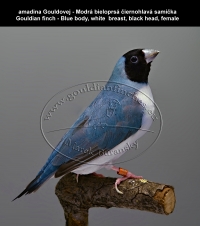
this website www.gouldianfinchces.eu
Contact:










